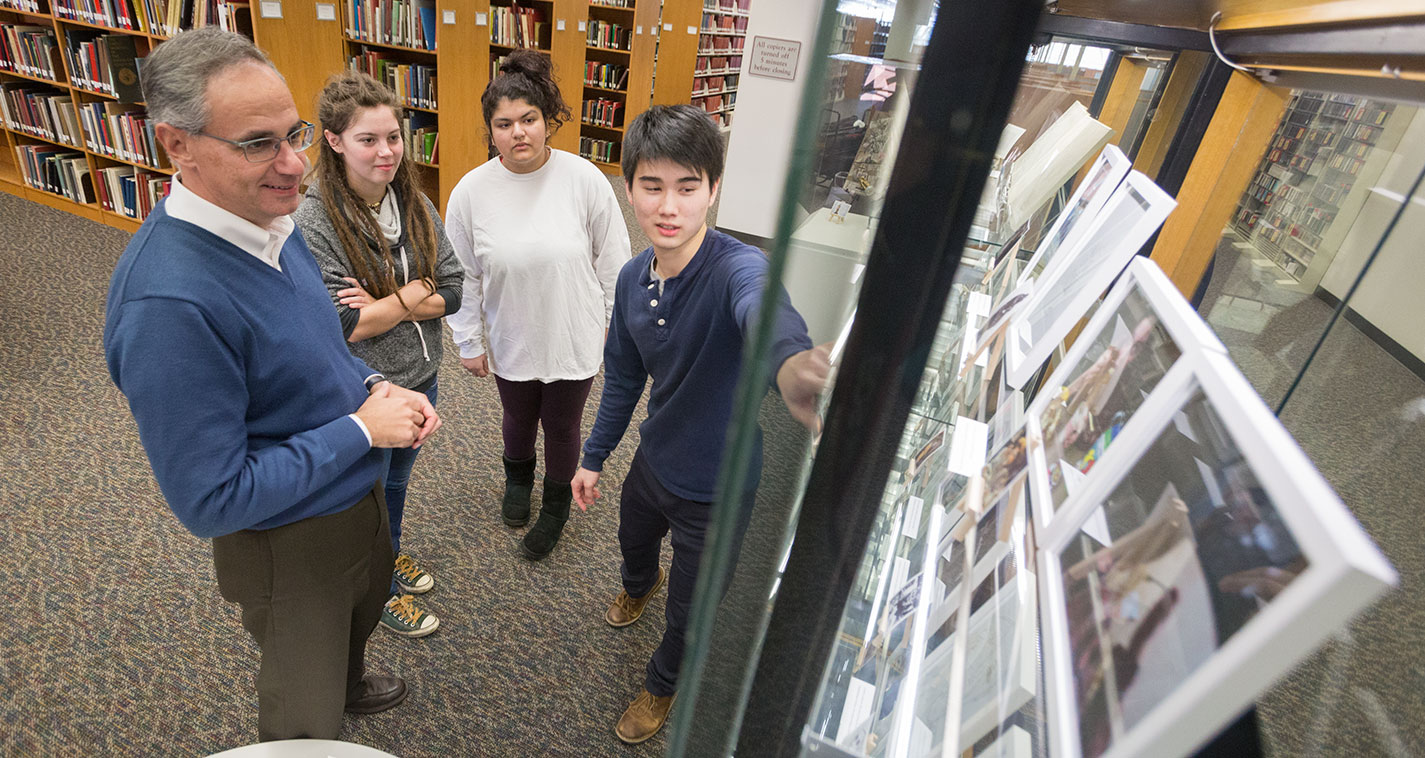Draped in a dark green overcoat, the man stood on a rocky precipice facing the sea. His hair was tousled by the wind and, despite his youth, he carried a cane in his right hand.
As he gazed over the fog that swirled beneath him, Grover couldn’t help but wonder — was he about to jump?
The man, captured in Caspar Friedrich’s painting “Wanderer above the Sea of Fog,” inspired Grover’s own image — which was included in the “PIECES and PARTS” exhibition in the Hatfield Library.
Comprised of drawings, photographs, collages and digital media, the 19 pieces were created this fall by students in art history professor Ricardo De Mambro Santos’ class, “Art Historical Inquiry: What is Art About?”
The new course aimed to help underclassmen understand the roles history and culture play in shaping people’s perceptions and definitions of art. The exhibition is the students’ capstone project.
For De Mambro Santos, the class reaffirmed his belief that the more students are challenged, the more they will excel.
“They are the makers of themselves. I’m the bridge helping them reach their capacities,” he says. “Their enthusiasm was mesmerizing. I can’t wait to teach this course again.”
Art’s Role in Society
During the semester, students examined paintings, sculptures and other media. They talked about the meaning of art and the definition of beauty, and they explored why some artworks were considered taboo during the 16th through 21st centuries, including Michelangelo’s “The Last Judgment” and Manet’s “Olympia.”
For their capstone project, the students chose an image — such as a famous painting or newspaper photograph — to analyze. Then they created their own version of the image and wrote an accompanying visual critique.
The resulting exhibition was partly sponsored by Willamette’s Mellon-funded Learning by Creating Program. It’s titled “PIECES and PARTS” because the students chose one “piece” and explained how it became “part” of their lives. “Parts” also plays off the word "arts."
De Mambro Santos added that he's especially thankful to the Hatfield Library for hosting the exhibition, which allowed him to transform a small space into a "potential pole of cultural attraction." He hopes the display gave people a new perspective on images that bombard their daily lives.
“Because of time and our habits, these original images have become so ordinary, so part of our lives, that we no longer pay attention to them,” he says. “But through critical thinking and historical research, we can still reimagine those images and make them talk to us.”
Reinterpretations
For her project, Grover went to the Vista House in the Columbia River Gorge. As the morning fog enveloped Crown Point, a friend stood behind Grover and took her photo.
Like Friedrich’s painting, Grover’s piece is mysterious. Only Grover knows she felt blissful at that moment.
“I felt very empowered by the nature around me, and I had a huge grin on my face,” she says about “Sublime.” “Putting myself in the image was a very joyful experience.”
Kari Millstein ’18 adopted a more philosophical approach for her piece, “What Will Remain?”
She based her painting and mixed collage on a photograph of the Golden Man atop the Oregon State Capitol. While the statue evokes pride among many Oregonians, Millstein sees it as a stereotypical man placed on a pedestal like a religious icon.
This perspective prompted Millstein to question the legacy humans leave behind. So she used a mixture of newspaper, magazines, a plastic statue and broken glass to share messages of transformation, progress, war and inspiration.
“This class made me more aware of people and how art can be used in different ways,” she says. “Art doesn’t have to be beautiful to have meaning.”
Grover and Millstein say De Mambro Santos’ class was unforgettable. Grover, an exercise science major, was so moved that she declared a second major in art history.
“Ricardo brings energy, passion and enthusiasm to everything he says and does,” she says. “He’s so passionate about what he teaches that you can’t help but want to go to class and learn.”
De Mambro Santos also felt charged by the class. He’s already planning on changes — and a new title — to make the course even better next fall.
“By the end of the semester, I felt reinvigorated. I felt fresher, newer,” he says. “I’m convinced I did the right thing by offering this course and that I need to keep teaching it.”



